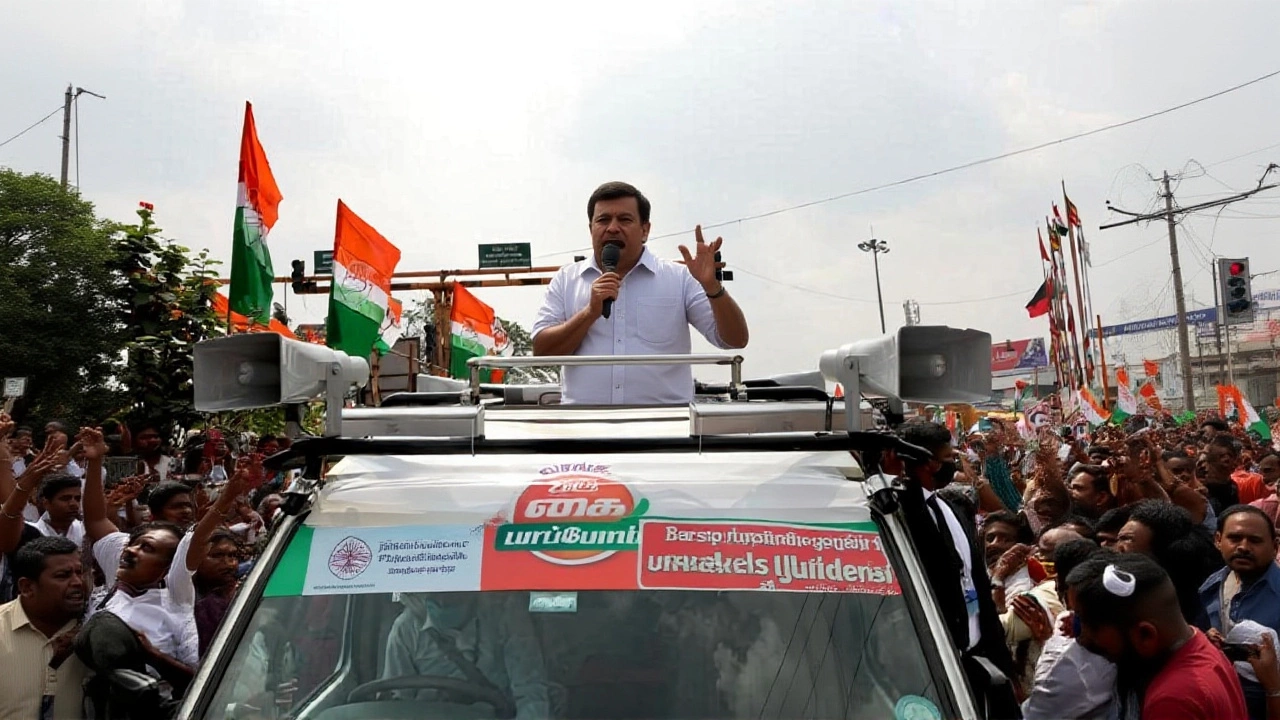
A massive fire tore through the wooden scaffolding surrounding the Badrakali Amman Temple in Sivakasi, Tamil Nadu, late on Sunday, November 20, 2022 — reducing the entire structure to smoldering ruins in under an hour. Devotees watching the night sky spotted the flames climbing the Rajagopuram, the towering gateway of the temple, and raised the alarm. Within minutes, two fire tenders from the Tamil Nadu Fire and Rescue Services arrived, battling the inferno under flickering emergency lights. By dawn, the fire was out. No one was hurt. But the scaffolding — painstakingly built for a multi-year renovation — was gone. The twist? It wasn’t faulty wiring or arson. It was crackers.
How a Wedding Procession Sparked a Temple Fire
The cause, according to Sivakasi Police, was shockingly mundane. A wedding procession passed within meters of the temple’s towering gopuram, and as part of local tradition, celebrants let off a barrage of firecrackers. One, perhaps a high-altitude rocket or a particularly volatile sparkler, landed directly on the wooden scaffolding. The structure, erected to support restoration work on the 100-year-old tower, was essentially a tinderbox — dry timber, bamboo lattices, and cotton ropes soaked in oil-based sealants. Within seconds, it caught. By the time temple staff reached the base, the upper levels were already a column of flame."We heard a loud pop, then saw orange light climbing the tower," said K. Selvaraj, a temple volunteer who was nearby. "We thought it was fireworks from the street — until the smoke turned black and the wood started cracking like gunshots."
The Temple and Its Cultural Weight
The Badrakali Amman Temple is no ordinary shrine. Dedicated to the fierce form of the goddess Kali, it draws tens of thousands of pilgrims annually, especially during the Navaratri festival. The Rajagopuram, standing over 120 feet tall, is a masterpiece of Dravidian architecture — ornate stucco figures of deities, mythological scenes, and celestial beings, all encased in a wooden frame for structural support during restoration. The renovation, begun in 2020, was meant to preserve these centuries-old carvings from weathering and decay. Now, that frame — and the temporary protective covering over the tower’s surface — is ash."It’s not just wood," said Dr. R. Meenakshi, a heritage conservationist from Chennai. "That scaffolding was holding up the original stone carvings. Without it, the structure is exposed to monsoon rains, birds, and wind. The damage to the artwork? We won’t know until the debris is cleared. And that could take months."
Why Sivakasi? The Fireworks Capital’s Dark Irony
Sivakasi is known across India as the epicenter of firework manufacturing. Nearly 90% of the country’s fireworks come from here. The town’s economy runs on gunpowder, fuses, and sparklers. Yet, despite this intimate familiarity with explosives, fire safety around heritage sites remains patchy. There were no firebreaks between the procession route and the temple. No permits were required for the fireworks. No designated safe zones. "We’ve seen this before," said retired fire officer T. Ramasamy. "In 2018, a temple in Madurai caught fire during a festival. Same thing — crackers, wooden scaffolding, no oversight. The difference? That one had a sprinkler system. This one didn’t."Response and Investigation
The Sivakasi Police have registered a case under Section 278 of the Indian Penal Code — causing a nuisance by hazardous act. The wedding organizers are being traced. Authorities are also reviewing whether the temple management violated safety norms by allowing combustible scaffolding to remain exposed during festival season. The Tamil Nadu Fire and Rescue Services has promised an audit of all active temple renovation sites across the state."We’re not blaming the family," said Senior Superintendent of Police K. Srinivasan. "But we’re asking: Why were fireworks allowed within 50 meters of a wooden structure under renovation? Why wasn’t there a fire watch? These aren’t hard questions. They’re basic."

What’s Next for the Temple?
The immediate priority is securing the exposed stonework from rain and humidity. Temporary tarpaulins are being installed. But the long-term plan? That’s still in limbo. The original scaffolding cost over ₹2.3 million. Rebuilding it will take at least six months. And with the monsoon approaching in December, time is critical."We’ve received donations from devotees already," said temple trustee P. Ramanathan. "But this isn’t just about money. It’s about trust. People came here for blessings. Now they’re asking: Did we protect what was sacred?"
Historical Precedents and Systemic Gaps
This isn’t the first time Indian temples have lost heritage structures to preventable fires. In 2015, the 300-year-old gopuram of the Meenakshi Temple in Madurai suffered partial damage from a similar incident. In 2020, a fire in Kerala’s Thirunavaya Temple destroyed centuries-old murals. Each time, the pattern repeats: festive activity, flammable materials, lack of regulation. And each time, the response is the same — shock, then silence."We have fire codes for malls, schools, even temples in tourist zones," said heritage lawyer Anjali Nair. "But for most local temples? Nothing. They’re treated as private religious spaces — exempt from municipal oversight. That’s a dangerous loophole."
What the Public Saw
Videos from the scene, shared widely on WhatsApp and Twitter, showed the gopuram glowing like a torch in the dark. Flames leapt 30 feet into the air. Crowds stood frozen. Children cried. One man ran toward the temple with a bucket — then stopped, realizing it was useless. The fire department arrived in 12 minutes. By then, the top third was gone."It felt like watching a cathedral burn," said local resident Latha Srinivasan, who filmed the event. "But it wasn’t a cathedral. It was our grandmother’s temple. The one she brought us to every Diwali."
Frequently Asked Questions
How did the fire start, and who is being held responsible?
The fire was triggered by firecrackers burst during a wedding procession near the temple. Sivakasi Police have registered a case against unknown parties under IPC Section 278. The wedding organizers are being traced, and temple authorities are under scrutiny for failing to enforce fire safety during renovation. No arrests have been made yet.
Was anyone injured in the fire?
No injuries were reported. Despite the intensity of the blaze, the fire occurred late at night when the temple grounds were largely empty. Firefighters arrived within 12 minutes and extinguished the flames before they could spread to the main temple structure or surrounding buildings.
How much damage was done, and what’s the cost of repairs?
The wooden scaffolding, valued at over ₹2.3 million, was completely destroyed. While the original stone carvings of the Rajagopuram remain intact, they are now exposed to monsoon weather. Repair costs are estimated at ₹8–10 million, including new scaffolding, protective coatings, and structural reinforcement. Funding is being sought from devotees and state heritage funds.
Why were fireworks allowed near the temple during renovation?
There are no state-mandated restrictions on fireworks near heritage temples unless they’re designated as protected monuments under the Archaeological Survey of India. Sivakasi’s temple is not on that list, so local authorities didn’t intervene. Experts argue this gap in regulation puts hundreds of similar sites at risk during festivals.
What’s being done to prevent this from happening again?
The Tamil Nadu Fire and Rescue Services has launched a statewide audit of all temple renovation sites. The state’s Heritage Department is drafting new guidelines requiring firebreaks, non-flammable scaffolding materials, and mandatory fire watches during festivals. A pilot program is expected in six districts by March 2023.
Is the main temple structure damaged?
Initial assessments suggest the stone and stucco of the Rajagopuram itself survived the fire. But without the scaffolding, the structure is vulnerable to moisture and erosion. Teams from the Archaeological Survey of India are expected to inspect the tower in the coming weeks to determine if any internal damage occurred to the underlying masonry.